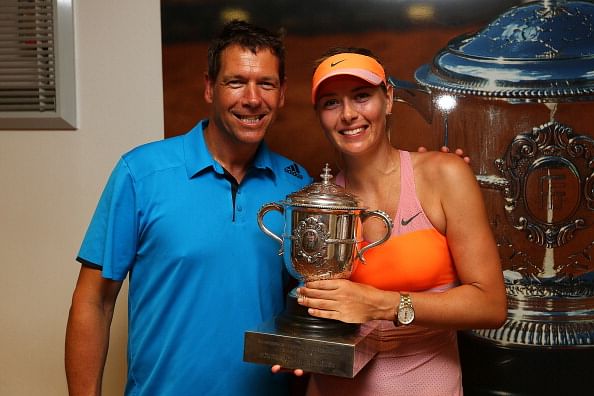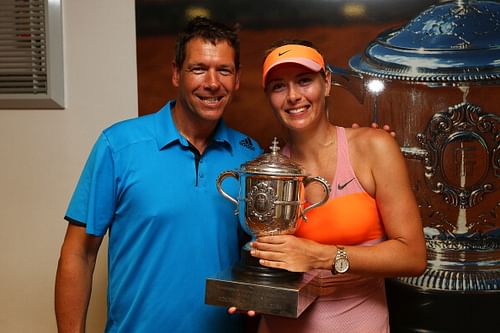
Maria Sharapova's improved game: The Groeneveld Impact

She won her first Grand Slam at the tender age of 17. And her trademark grunts, grit and focus catapulted her to the highest echelons of women’s tennis. Maria Sharapova has been a top contender in the women’s game since 2004. But her road to greatness has not been easy, as she had to make a comeback after a hiatus due to a shoulder injury in 2009.
A five-time Grand Slam champion and a former World No. 1, Sharapova started playing tennis under the gaze of her first coach Yuri Yutkin. Her father played a key role in her formative years.
In a sport that is so physically and mentally demanding, Sharapova has achieved a rare longevity which only a few other greats like Steffi Graf, Martina Navratilova, Venus Williams and Serena Williams have achieved. She is one of the best competitors the sport has ever seen. Nobody resets in between points as well as she does. Whether she is leading or trailing in a match, her focus and intensity seldom abandon her.
Sharapova’s routines are the same before every point. She turns her back towards the opponent, walks beyond the baseline, adjusts her racquet strings, turns around and takes her position at the baseline, bounces the ball twice, tosses the ball high up into the air and executes the serve with a loud grunt.
Having been on tour for so long and with 34 WTA titles under her belt, she could, arguably, have achieved a lot more than she has. What has probably limited her has been her one dimensional game. She loves slugging it out from the baseline by hitting the ball hard and flat, which can get predictable. Over time many of her coaches did fine tune her game and worked on improving her movement on court.
However, it was only in 2013 when her game adopted new dimensions – thanks to her new coach Sven Groeneveld. Groeneveld, a former Dutch professional player, has coached the likes of Monica Seles, Mary Pierce, Ana Ivanovic, Aranxta Sanchez Vicario and Michael Stich, all of whom are former Grand Slam champions.
The positives
Sharapova’s chemistry with Groeneveld
Sharapova worked with Thomas Hogstedt from 2010 to 2013. After parting ways with him, she hired the legendary Jimmy Connors and fired him after just one match, citing chemistry issues with him. When Groeneveld took charge as her coach, he ensured smooth a transition and gave a frank opinion of her game then.
"From the first time we met I really liked what he had to say," Sharapova has said. "I like when someone comes in and is honest and truthful and says it like it is. He's that. He puts it all out on the table. He's a team player. He works with everyone on my team, something I was missing for a little bit of time."
Groeneveld has a calm demeanor like Hogstedt, and is often seen to be quietly encouraging of Maria’s abilities. The coaching partnership did not take much time to show results as Sharapova had a great run in 2014, especially on clay. Having described herself as a cow on ice until she won her first French Open in 2012, the red dirt has been her best surface.
After winning at Stuttgart and Madrid, Sharapova continued one of the best runs of her career to lift a second French Open with Groeneveld by her side. She was also very consistent during the rest of the season, and she carried over the momentum into 2015 by winning at Brisbane and reaching the finals of the Australian Open.
Adding the drop shot to her repertoire
Apart from consistency, Groeneveld has helped Sharpova add many more elements to her game that were missing before. The drop shot had been an element that never seemed to exist in her repertoire. Since the last season though, irrespective of the surface she plays on, Sharapova uses the drop shot frequently, with a fair amount of deception.
She has found a lot of success in doing so; she has been able to master the shot quickly and is now able to cut down the rally length by introducing this element of surprise. The drop shot often has vicious side spin that moves the ball away from the opponent, thereby making it a winner on more occasions than one.
Watch this delightful drop shot that Sharapova executed to perfection against Serena Williams in the Australian Open final 2015.
Using the backhand slice more frequently
The double handed top-spin backhand was the only shot that would come to Sharapova’s rescue off that flank. She would hit backhands with acute angles and vary them in depth, but that’s where the versatility of the shot ended.
Groenveld has helped Sharapova add the backhand slice to her arsenal, thereby making her game less predictable and adding strength to her defense. Sharapova employed the one handed backhand slice on various occasions in this year’s Australian Open.
This is an excellent change up to her game as she now uses it effectively to neutralize rallies and reduce the pace of the ball, thereby drawing unforced errors from opponents at times.
Optimal use of power
Over the years Sharapova has been known for power hitting. Most analysts describe her style as “hit hard, then hit harder”. Even after taking an opponent off the court with a serve out wide or a deep crosscourt forehand, Sharapova would follow it up with another booming groundstroke into the open court. Though this may not have been necessary all the time, she really did not know any other way to play the shot.
Ever since Groeneveld has taken over though, it is quite conspicuous that Sharapova deploys power depending on the need. These days one can see her gently push or nudge the ball into the open court, thereby making optimal use of her power and also reducing the chance of unforced errors.
The challenges
The Serena Williams conundrum
The last time Sharapova won against Serena Williams was a good 10 years ago. Serena has dominated each of their last 16 meetings, including this year’s Australian Open final. Getting the better of Serena would definitely be one of the goals Sharapova would have set with each of her coaches, past and present. However, she seems to get the recipe wrong every time.
While playing Serena, Sharapova tries to make that extra effort to keep the ball deep and keep the aggression a notch higher. But even that extra bit of aggression either goes overboard, resulting in her spraying a lot of unforced errors, or falls short due the sheer might of Williams. Groeneveld’s biggest challenge is to help Sharapova get that calibration right.
The double fault count
A layman would probably wonder how someone who has a towering height of 6 feet 2 inches would find it difficult to get the ball to cross over to the other side of the net while serving. In the last season and the current one, the double fault count has been unbelievably high for Sharapova. It is surprising how she still manages to win some matches despite the high number of double faults.
Losing the mental edge
Maria Sharapova is the epitome of focus. Her ability to shut out everything and just be in the present is a unique gift many players would want to possess. Picking on her racquet strings, taps of encouragement on her thigh and the clenched fist are often enough for her to reset and put the previous point out of her mind. After losing the first set, her ability to come out firing on all cylinders and swing the momentum to her side at the start of the second is commendable.
However, in this season, some of the players have managed to rattle her cage. She has been pretty inconsistent post the Australian Open; her clay swing this year has not been as impressive as it was last year. She lost early in Stuttgart and in the semifinals of Madrid, both of which she had won last year.
Sharapova seems to get nervous on crucial points these days. This is something that has always been alien to her champion mindset.
Sven Groeneveld has managed to tap into unchartered territories of Sharapova’s potential. He has helped the Russian to add more variety to her game, as a result of which her game has reached a new high. If she has to successfully defend her French Open title though, Groeneveld has to help Sharapova regain her mental edge, as it is by far the biggest weapon in her arsenal.